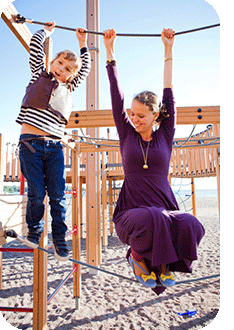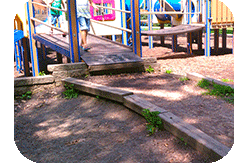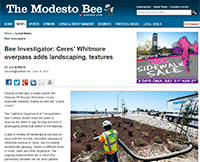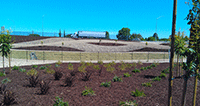What if Parents were Banned from Playgrounds?
Author: Chad Kennedy, Landscape Architect, ASLA
 As a certified playground safety inspector I tend to view play spaces a bit differently than many adults who enter a play space. I almost unconsciously recognize every visible flaw, abnormality and safety offense whether large or small. Armed with the knowledge of what risk and hazards are typically present, I am usually not overly concerned with the majority of infractions discovered when at play with my family. Recently, while on vacation in the greater Chicago area this summer with my family, we made a late morning visit to a local neighborhood park. On this occasion I was amazed at the lack of maintenance and the amount of hazards present. Metal wires were showing through worn rope climbers, ramps suddenly ended where paths once were (see photo below), only remnants of engineered wood fiber could be found on the soil surface and many pieces of equipment were rusted with age. During this visit, I may became one of the "helicopter parents" so widely criticized in society. Recognizing hazards in the play area, an innate response emerged prompting me to help the children navigate the environment so they could avoid and identify the hazards. Parents and safety organizations are often criticized for not giving children space to trip, fall, get hurt and learn for themselves. So what would happen if parents were discouraged from participating in or even banned from play spaces and the children were left to their own devices? Would it be the child's fault if they played on and were hurt on an unsafe playground designed by adults?
As a certified playground safety inspector I tend to view play spaces a bit differently than many adults who enter a play space. I almost unconsciously recognize every visible flaw, abnormality and safety offense whether large or small. Armed with the knowledge of what risk and hazards are typically present, I am usually not overly concerned with the majority of infractions discovered when at play with my family. Recently, while on vacation in the greater Chicago area this summer with my family, we made a late morning visit to a local neighborhood park. On this occasion I was amazed at the lack of maintenance and the amount of hazards present. Metal wires were showing through worn rope climbers, ramps suddenly ended where paths once were (see photo below), only remnants of engineered wood fiber could be found on the soil surface and many pieces of equipment were rusted with age. During this visit, I may became one of the "helicopter parents" so widely criticized in society. Recognizing hazards in the play area, an innate response emerged prompting me to help the children navigate the environment so they could avoid and identify the hazards. Parents and safety organizations are often criticized for not giving children space to trip, fall, get hurt and learn for themselves. So what would happen if parents were discouraged from participating in or even banned from play spaces and the children were left to their own devices? Would it be the child's fault if they played on and were hurt on an unsafe playground designed by adults?
I am definitely a proponent of providing risk in play spaces where children can learn, in a social environment, the consequences, both good and bad, of decision making. This being said, children should not be required during the act of play to distinguish between a simple risk and a potentially life threatening or debilitating injury. This determination should be the responsibility of an adult. In fact, 40% of injuries in play areas are due to improper supervision and 44% are due to improper maintenance practices.1 For this reason I am an advocate of actively engaged parents engaged in play with children. Not every play space is designed, maintained or constructed to safety standards. The only way to identify hazards is to be involved. Creative parents can find ways to play with children, monitor the situation, and allow risk and challenge to be present without hovering. I am also an advocate for parental education of common hazards that exist in play environments. To that end, below is a brief description of the differences between risks and hazards.
Risk vs. Hazard
Risk in the playground is essential for children's growth. Risk is a play opportunity that creates challenges allowing opportunities to succeed and/or fail based on individual reasoning and choices. Hazards on the other hand are elements or circumstances in the environment that a child is not expected to comprehend, see or foresee. As an example of this, a child may evaluate the risk involved with climbing an arch ladder to a raised platform. Ultimately deciding to take the route or not, based on his or her level of comfort with the risk. This same child however is not expected to understand or assess the danger involved with spacing of the rungs and the potential of head entrapment, or the potential for clothing to become entangled on a bolt that protrudes too far from the structure.
Common Hazards Parents should be aware of common hazards in play areas. Some of which can cause serious damage or death. This is just a short list of a few to be aware of:

- Play equipment that crush or cut fingers and limbs.
- Bolts or gaps that catch and entangle loose clothing and strings.
- Bolts or small items that protrude out and have potential for impalement.
- Sharp or worn corners and edges that cause cuts and abrasions.
- Hot surfaces (metal slides) that burn skin.
- Inadequate or lack of surfacing for fall heights.
- Rusting, cracked or worn equipment and hooks.
- Missing bolts and equipment.
- Hard items or paving within 6' of play equipment.
- Misaligned platforms, posts and barriers.2
Play areas are meant to be fun, whimsical and carefree! This article is not meant to be a doomsday, negative report on society's failure to allow safe play. In fact, due in part to the establishment of play standards and education efforts, in most cases, safe play is the norm. Parents should however be reminded that not all play areas, as evidenced by my family trip, are created equal and that proper supervision and involvement in play should always be a priority. I cringe at the thought of what play areas would become if parents were discouraged from partcipating in or even banned from the play environment.
1.-NPSI Curriculum Committee - Syllabus for the Certification Course for Playground Safety Inspectors. National Playground Safety Institute. V 1.2009.
2-U.S. Consumer Product Safety Commission. Public Playground Safety Handbook. CPSC. Bethesda, MD. 2010.
 As a certified playground safety inspector I tend to view play spaces a bit differently than many adults who enter a play space. I almost unconsciously recognize every visible flaw, abnormality and safety offense whether large or small. Armed with the knowledge of what risk and hazards are typically present, I am usually not overly concerned with the majority of infractions discovered when at play with my family. Recently, while on vacation in the greater Chicago area this summer with my family, we made a late morning visit to a local neighborhood park. On this occasion I was amazed at the lack of maintenance and the amount of hazards present. Metal wires were showing through worn rope climbers, ramps suddenly ended where paths once were (see photo below), only remnants of engineered wood fiber could be found on the soil surface and many pieces of equipment were rusted with age. During this visit, I may became one of the "helicopter parents" so widely criticized in society. Recognizing hazards in the play area, an innate response emerged prompting me to help the children navigate the environment so they could avoid and identify the hazards. Parents and safety organizations are often criticized for not giving children space to trip, fall, get hurt and learn for themselves. So what would happen if parents were discouraged from participating in or even banned from play spaces and the children were left to their own devices? Would it be the child's fault if they played on and were hurt on an unsafe playground designed by adults?
As a certified playground safety inspector I tend to view play spaces a bit differently than many adults who enter a play space. I almost unconsciously recognize every visible flaw, abnormality and safety offense whether large or small. Armed with the knowledge of what risk and hazards are typically present, I am usually not overly concerned with the majority of infractions discovered when at play with my family. Recently, while on vacation in the greater Chicago area this summer with my family, we made a late morning visit to a local neighborhood park. On this occasion I was amazed at the lack of maintenance and the amount of hazards present. Metal wires were showing through worn rope climbers, ramps suddenly ended where paths once were (see photo below), only remnants of engineered wood fiber could be found on the soil surface and many pieces of equipment were rusted with age. During this visit, I may became one of the "helicopter parents" so widely criticized in society. Recognizing hazards in the play area, an innate response emerged prompting me to help the children navigate the environment so they could avoid and identify the hazards. Parents and safety organizations are often criticized for not giving children space to trip, fall, get hurt and learn for themselves. So what would happen if parents were discouraged from participating in or even banned from play spaces and the children were left to their own devices? Would it be the child's fault if they played on and were hurt on an unsafe playground designed by adults? 

